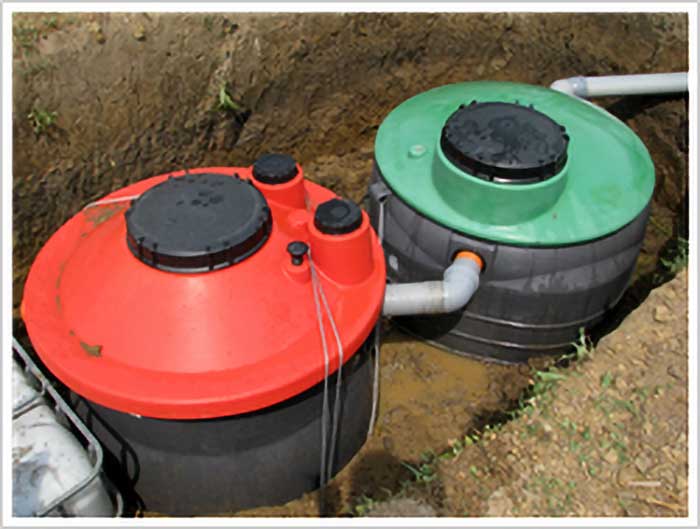When it comes to the management of wastewater, homeowners sometimes may have the option of using a septic system. Utilizing a new septic systems would consist of a new septic tank, which are large concrete tanks, and a leach field or drain field, to disperse the effluent (the liquid waste that goes from the septic tank into the leach field, along with other groundwater, into the soil.
This is not typically a DIY project that homeowners normally take on, even those experienced DIY installers know that a new septic tank system is a huge undertaking, which is part of why installation costs can be so high compared to other relatively simple DIY home improvement projects. Most projects involving sewer lines or wastewater treatment can involve heavy equipment and quite the installation process, not to mention the onsite tests (such as a percolation test) and the many permits needed from your local health department. These can all add to what the septic tank costs to get installed.
These tests are important as they will let you know what type of system and size of tank you’ll need, with the normal size being a 1,000-gallon tank. The sewer system you choose will also depend on where you live, whether in rural areas or other places where an alternative septic system may be required. Going with a concrete septic tank may not be the best choice for your new home, and some mobile home areas do not have the needed space for a conventional septic system.
.
How to Prep For Your Septic Tank, Installation
The process begins with paperwork. You will have to contact officials for your city, county, and state at the very least, and you may also need to talk to other people involved with your property, such as a community council, mobile park owner, etc. Not every property is allowed to have a septic tank installed; there are certain requirements that have to be fulfilled. These authorities need to know the dimensions of your proposed septic tank and drainage/leach field. Remember to take into account replacement or expansion plans you may have later on, as well as setbacks, the ability to access the tank for maintenance, etc.:
- You need a drawing of the proposed location that is to scale; usually speaking, you will need to see that you have ¾ of an acre available for this installation.
- Then you have to examine the seasonal high water table or the limiting soil layer—is there enough depth for the septic tank you want to install? You will have to have no less than four feet before you hit a limiting soil feature if you want to install a tank.
- As for your septic system, you will need maintenance vehicles to be coming through to reach the tank, and these vehicles are heavy. You need to make sure that they will have an access path that does not take them over the tank or pipes.
After these calculations, you can draw a map with your tank and drain field to give to authorities, along with the other necessary documents. Then you could be allowed to proceed with your plans, or you may be told of revisions you need to make before you can proceed. Then once you have the green light, you will have to inform your local utilities that you want to dig. Then someone will come to plot out where the utility lines are so that you do not hit them; you will also need to use chalk or white paint to show where you plan to dig.
If you have experience in construction, or in using a backhoe or crane, then you may be up to the challenge of installing a septic tank. You could also need a number of permits, depending on your area, such as:
- septic tank permit,
- building permit
- water rights permit
- utility permit,
- occupation permit
Some of the items you will need for the job include a backhoe, crane, a laser level, and shovels. Then with work gloves, coveralls, hip boots, and goggles, you can be ready for this major project.
.
Tips for Your Septic Tank Installation
This starts with using a backhoe to create a hole for the septic tank and to dig out drain field trenches. As for actually installing the tank itself, you need a certified contractor to help you with this, as a mistake with moving a tank can result in severe injuries or even death. Whether using plastic septic tanks, fiberglass or concrete septic tanks, they will be very heavy and will need to be carefully lowered into the hole, and the bottom and upper halves of the tank need to be firmly in place and aligned. Once in place, you will have to put in enough water into the tank (manufacturer instructions will tell you how much this is), aka backfill. A tank that is overfilled can rupture.
The overflow pipe extending from the septic tank will have to go into the drain field trenches. You will also need to install the mesh containers of the septic medium into those trenches. After everything is installed, you will need to inspect for any leaks. Once everything is good to go, you can carefully refill the excavations, but do not dump earth over the top of the septic tank, so you can get to the hatch for maintenance. Sometimes tank risers are used to give access to the tank. Access can be important for any clogging that occurs with solid waste, in the PVC pipe or tank pump.
These water treatment systems allow for homes in rural area to have proper wastewater treatment.
.
The Septic System Installation Expertise You Can Rely On
As you can see, this is not a task for a novice do-it-yourselfer to tackle. Even if you have completed some difficult projects on your property, there are jobs best left to the professionals or that require an expert’s help. One mistake could not only result in health-threatening contamination, but it could lead to hefty fines as well.
There is nothing simple about installing a septic tank or system. If you are looking for a Kansas City plumber with the qualifications and experience you need for a septic system job, look no further than A-1 Sewer & Septic Service, Inc. Our team of expert plumbing technicians can handle any issue you face with plumbing, whether great or small. To learn how we may be able to help you with installing a septic system, do not hesitate to get your septic tank system replacement quote when you contact us today.


